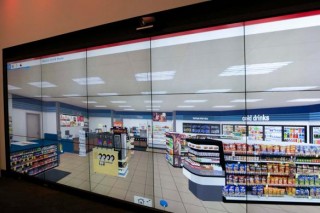In these fast-moving times where one change comes hot on the heels of the last, fresh ideas are needed to stay ahead of the game while providing customers with an attractive shopping experience that adds value. But innovation can mean lots of different things, and applies to a whole host of services and tasks these days. But is it just hot air or a genuine game changer? We take a look at the retail sector to see what’s happening in the sphere that the creative spirits and innovators of tomorrow call home.

Innovations at companies
From incubators and innovation labs to hubs – lots of big companies are taking a fresh look at the way they foster innovation. After all, there’s no future without it.
Thema:
Digitalisation
Digitalisierung
fresh look
future
hub
ideas
Ideen
incubator
inkubator
innovation
innovation labs
innovationslabor
testlab
Zukunft
Innovate me!
According to the Global Innovation Index (GII), which looks at the world’s most innovative economies, Switzerland rules the roost, followed by Sweden, the US and the United Kingdom. Taking Europe in isolation for a moment, Austria ranks 11th out of 39. Particularly in countries at the top of the list, there are plenty of companies that are firmly committed to innovation and driving progress, and have the internal structures in place to achieve it.
So it’s easy to see why innovation labs have been popular for some time now. As internal incubators, they give companies much-needed creative space where they can try out new ideas and analyse trends. This gives them the freedom to work on fresh product and service concepts, as well as new business models that have the potential to expand their portfolios. The labs help businesses to develop strategies for turning innovative ideas into serious projects which, ideally, can be deployed in their stores.
A business’s ability to innovate is key to its survival in a constantly changing market. In many areas, simply tweaking existing products is no longer enough to stay on top. The trick is to come up with completely new approaches, ideas and structures so that they can hold their own in future. However, this calls for creative thinking and open, unrestricted spaces for precisely that purpose. As many corporate structures stand in the way of processes like this, companies tend to spin off their innovation labs into separate entities. This stakes out the kind of protected zones and collaborative working environments needed for the creative process to flourish, while allowing the companies behind them to reap the rewards of the insights and experience they generate. Although innovation labs are already well established, they are set to play an even more prominent role in future.
Whichever way you look at it: innovation fever has taken hold.
They are the ideal way for companies to experiment with more radical innovations that fall outside their day-to-day activities. It also means that the viability and problem-solving potential of new ideas can be evaluated quickly and efficiently, and any necessary adjustments made. Ultimately this translates into greater efficiency for businesses, as the process also speeds up the development of products, concepts and advertising. With the potential that they have to help expand portfolios. Innovation labs drive the pace of innovation in all parts of a company. The increased success of set-ups like this is reflected in the bottom line: around two-thirds of DAX 30 companies either have their own idea labs already or are in the process of setting them up.
The future of retail
US retail giant Walmart has set up a retail innovation lab to help the group stay competitive in the digital world. It even has its own “playground” where various innovations can be put through their paces. The aim is to find ideas that blur the boundaries between the online and offline Walmart shopping experiences even more.

The store in Levittown, New York, has reinvented itself as a kind of innovative area where customers can try out some of the latest breakthroughs without realising it. Taking the form of a high-tech incubator store fitted with cameras, interactive displays and a huge data centre, it uses artificial intelligence to conduct research into the retail environment of the future – in true sci-fi style. Massed ranks of sensors, cameras and processors collect real-time information on everything that happens.
Installed throughout the store, the cutting-edge tech is all in the name of enhancing the consumer experience (CX). The idea is to create a unique CX to explore the possibilities opened up by AI and look at the bearing it has on customer interactions. The store is referred to as the Intelligent Retail Lab, or IRL for short. While use of AI is now standard practice in e-commerce, it has made far fewer inroads when it comes to bricks-and-mortar stores. And that is exactly what the IRL is looking to investigate.
Testing new innovative ideas in a real-life store stocked with more than 30,000 items will enable Walmart to find out more about the business and its customers, and do so more quickly.
For example, the technology in operation at the Walmart lab uses a combination of cameras and real-time analysis to automatically trigger notifications to internal apps when stocks run out. The app then lets employees know that they need to restock. With AI already in a position to automatically identify when specific products are running low and shelves need to be resupplied, customers will no longer experience the frustration of missing out on their favourite products. Innovative solutions like this also help to make the day-to-day running of the store much more efficient.
And there’s no longer any need for workers to scour the store to find out which shelves need to be restacked. This technology delivers practical solutions with real-world applications to create an altogether more convenient shopping experience for all concerned. With all-round customer care now firmly in the can, everything runs smoothly: from stock monitoring to trolley availability and dynamic check-out opening for optimal queue management.
All of this points to the increasing role played by AI in our lives, as well as the myriad potential for synergies that it brings. Combined with Walmart’s extensive store-related experience, the wealth of information accumulated at the IRL helps create a unique mix that gives rise to innovative and customer-focused experiences.
Staying in America for a moment, Coca-Cola is also working on new food and beverage innovations at its Atlanta headquarters. At KOlab, Coca-Cola’s very own innovation lab, identifying new ways of reaching out to customers is the order of the day. The idea is that the customers take centre stage, making them the research focus.

Participants can use something called a Digital Immersion Room, where the customer shopping experience is recreated in virtual reality. Customers are shown new merchandising solutions with Coca-Cola products visualised in in-store environments. Retailers can use the system to find out how customers pick out specific drinks on the shelves, while restaurant owners can find out how best to interact with visitors through new chiller units or digital menus. The laboratory allows Coca-Cola to nurture relationships with its restaurant and retail customers in the quest for new ideas. This approach helps create innovations and mutually beneficial solutions that respond to current trends while keeping a close eye on the next generation of consumers.
Swedish furniture giant IKEA is committed to using innovations to improve its customers’ daily lives. The goal is also to keep on innovating, because this has always been at the heart of what IKEA does, as a look at their product development activities and store designs shows. So it’s hardly surprising to learn that IKEA has teamed up with a cool innovation lab in Copenhagen – Space 10. Located in a former fish factory, this research space has better and more sustainable living in its sights – with and for IKEA. Major changes facing society today such as urbanisation, scarcity of resources, climate change, food insecurity and loneliness provide the starting point for their activities, and are all subjects that are very close to IKEA’s heart.
Collaborating with experts, designers, architects and artists from all over the world, the idea is to identify potential solutions to these challenges that, ideally, can be turned into viable products and services. Important work indeed, given that IKEA’s global presence means it has to consider all the different ways that people across the world live their lives. This particular research undertaking is something of a barometer for the future, with work already under way on various projects such as a drive to democratise access to clean energy through solar power. Another initiative, about the future of food, has already led to the publication of a cook book entitled Future Food Today.
The Austrian take on innovation
But you don’t have to look far afield to find innovations. Companies in Austria also have a strong research focus, as well as their own dedicated innovation spaces. Such as the Agro Innovation Lab. As the innovation platform for the Raiffeisen Goods Organisation it sees itself as a trend scout, catalyst for change, point of contact, networker, creative thinker, store of knowledge, partner and intermediary. The lab’s goal is to actively shape the future of agriculture while providing a central point of contact for the agricultural innovations of tomorrow. It promotes the kinds of new technologies and strategies with the potential to save resources and make the lives of farmers – and consumers – easier. By combining traditional farming expertise with the opportunities opened up by digitalisation, it helps initiate new networks while creating a space for innovation.
Whichever way you look at it, there is no getting round innovation and digitalisation. By helping businesses to keep in step with the times and lead from the front, innovation labs are a great way for companies to look at possible new approaches away from their day-to-day operations and shape the future a little more each day in the process.
Categories

As natural as it gets
This trend is set to have a significant impact on the food industry for some time to come: deprocessing.
MAXFIVE

“Aha, so bricks-and-mortar retail isn’t quite dead after all”
We talk about the new big picture of retail.
MAXFIVE

Too much of a good thing
Ideas for a responsible approach to foodstuffs
MAXFIVE
